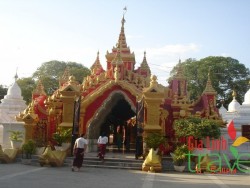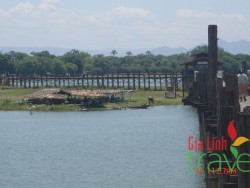Mandalay
MANDALAY


Mandalay

Mandalay
Mandalay is the second largest city in Myanmar and was established in 1857. It lies on the east bank of the Ayeyarwaddy River and in the upper part of Myanmar. Mandalay has the Royal Palace of the last Konbaung Dynasty. Mandalay inherits many cultural heritage from the ancient Myanmar Kingdoms and beautiful places to visit.
Former capital of Myanmar until British annexation in 1885 is the cultural center of the country as well as being the commercial and Buddhist education-center for the whole Myanmar. Geographical focus from four corners of country, Mandalay is about 700km from the north of Yangon, situated between the vast plain of Ayeyarwady river’s terrace and plateau of Shan state in the east, and just on the foot of historic Mandalay hill.
Mandalay was founded by King Mindon of Koneboung dynasty in 1852.The royal palace, established at the center of royal compound protected by immense brick wall and moat, four gates at sides, covers 2 square kilometers, which had been completely destroyed, except palace’s wall with fort, during World War 2, but in recent years, the reconstruction has been finished. Although many significant places to explore in Mandalay, it is quite interesting to visit the palace site for nostalgic thinking, if time permits. Not far from palace, Mandalay hill, with 235 meters above sea level, is absolutely a pleasant place to contemplate the sunset.
Major Attractions:
- Mahamuni Pagoda
Locally named Phayagyi which means Great Pagoda, is the most sacred place in Mandalay where hundreds of Buddhist is praying, in most of the time, in front of a venerable bronze statue of Buddha image whose height is 1.5 meters, placed on the golden throne, which is thickly covered by layers of gold leaves, except the face. As a particular wonder, only the men can go inside to apply small packets of gold leaves on the statue’s surface. Unique ceremonial scene of wash for Buddha statue, at every dawn, lead by venerable monks and attending many laic disciples, is a record of graceful time. The collection of Khmer bronze statues dated back to 15 century, in a sanctuary of Mahamuni pagoda, is well known for typical beauty of Cambodian art and for a local popularity which tells that their power can cure the illness of human body when the corresponding parts of figurines are seriously touched by hands. As dynamic as a small town, main entrance of Mahamuni pagoda, is fascinating with many shops on each side where Buddhist monks’ utensils like bowl, umbrella, robe, and other faith-related items like statues, chaplets, books of sermons, and varieties of handicraft can be found.
- Kuthodaw Pagoda
Other historic pagodas in the city are numerous, among them- Kuthodaw pagoda of king Mindon from 19 century, situated on the foot of Mandalay hill, where hundreds of white temples, despite the small size, to shelter the sacred writings of Buddhist philosophy, being carved on the white marble slabs, attracts many visitors by famous name of the world’s biggest book.
- Shwenandaw Monastery
The old wooden monastery of Shwenandaw, next to Kuthodaw, is considered as type example of Myanmar architecture of 19 century where huge teak pillars as well as decorative teak sculptures are marvelous. The royal usage of gold leaves in this monument is remarkable; interior is visibly covered, because it was one of the royal buildings of Mandalay palace under the reign of king Mindon.
Mandalay is always rich with its places of craftsmen where old traditional techniques are still used, for instance, area of gold-leaf makers, in 36th street between 77th and 78th streets, is well known to explore how they work delicately for sacred gold-leaf. And then, bronze-casting workshops, usually for huge size of Buddha images, are unique to enjoy. Many more are such as tapestries, marble Buddha sculptures, woodcarvings and others. A visit to these workshops is truly a visit back in time.
Full day excursion in the environs of Mandalay includes the former capital cities of Amarapura, Ava (Innwa), and Sagaing. The Mahagandayon monastery, which has over 1,000 monks, one of the largest monastic education centers of country, is considered as major place of interest in Amarapura. Besides, the 1.2km long U-Bein Bridge, at the middle of beautiful Taungthaman lake, built over 150 years ago from teaks taken from the Ava royal palace, is always enchanting place and spectacular view of sunset can be seen from the place beneath the bridge.
Ava, an ancient capital between 14 and 18 centuries, may be explored by horse and carriage through the villages and ruins of ancient splendors, after crossing a small river by boat. Beautiful teakwood Bagaya monastery and Maenu Okkyaung monastery are interesting places to visit by horse cart. Quiet and peaceful, hidden in a picturesque landscape of toddy palms, rice fields, the ruins of ancient temples are the gifts of nature in Ava.
After that, Sagaing is known as a retreat center for Buddhist devotees that support dozens of monasteries and nunneries as well as a major monastic hospital. Most spectacular is the sunset, seen from a hill-top Son Oo Ponnyashin pagoda, offering a beautiful panoramic view.
Mingun
A nice typical village across the Ayeyarwady River, was royally denoted as recreational place for noble families during the time of monarchy. One hour boat trip, about 12km upriver from Mandalay, brings the most scenic points along the river side. Upon arrival, the huge bell of Mingun with its weight of 90 tons and the unfinished brick pagoda with its impressive cracks caused by an earthquake must be particularly attractive for sightseeing.
Monywa
Around 140km to the west of Mandalay is Monywa, a major trading center of agricultural products come from nearby Chindwin valley. The monumental high-lights are the Thanbodday pagoda with its 500,000 Buddhas, the Baddhi-tataung pagoda with its grove of 1,000 sacred banyan trees and the huge reclining Buddha in concrete. On the opposite side of Chindwin River are Phowin Taung caves, a recently opened archeological complex of caves containing thousands of frescos inside the caves depicting daily life of ancient time, some dating back to the 14th century.
Pyin Oo Lwin
A short drive, 80km to the east of Mandalay is the former British hill station of Maymyo, now renamed as Pyin Oo Lwin where one can find the colonial vestiges. A visit to the market, the old clock tower and recently renovated botanical gardens, are not to be missed. A drive around town by antiquated horse-cart, especially in the areas of old buildings from British era, suits with its cool and clean atmosphere. For train lovers a ride from Mandalay to PyinOoLwin offers stunning views as the train zigzags up and down the mountainsides. It is five hours more by train to Thipaw (Hsipaw), a nice hilly town that has retained Haw or old Palace of Shan Seigneurs, and good base for treks in northern Shan state. The particular wonder along the scenic journey by train is Gokteik Viaduct, 300meters above a gorge in mountain ranges
